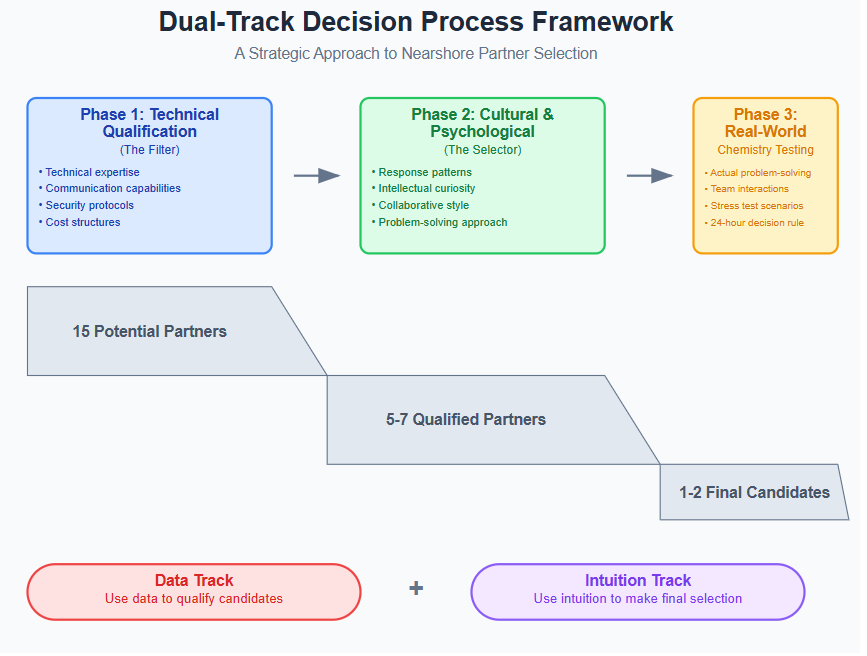
Security-First Culture in Nearshore Teams: Scale Securely
Transform your security team from bottleneck to enabler with security-first nearshore development. Avoid vulnerabilities and scale securely. Learn more.
Read More

How a CTO's journey from spreadsheets to instinct revealed the hidden psychology behind choosing the right nearshore partner
Sarah Chen had everything mapped out in her Excel spreadsheet. Technical expertise ratings, cost comparisons, communication scores—fifteen potential nearshore partners reduced to neat columns of data. As CTO of a fast-growing fintech startup, she'd spent three months methodically evaluating every conceivable metric across regions: Asia, Eastern Europe, LATAM. Yet, as she stared at the screen at 11 PM on a Thursday, something felt wrong.
The top-ranked partner looked perfect on paper. Their technical portfolio was impressive, their rates competitive, their English fluent. But during their final presentation, Sarah found herself checking her phone. The conversation felt transactional, almost robotic. Meanwhile, the third-ranked team—slightly more expensive, with a smaller portfolio—had somehow made her lean forward in her chair, genuinely excited about possibilities she hadn't even considered.
"I'm overthinking this," she told herself. The data was clear. But her gut was saying something entirely different.
What Sarah didn't realize was that she was experiencing what psychologists call the "partnership paradox"—the disconnect between what we think we want in a business partner and what actually drives successful long-term collaborations. After interviewing dozens of CTOs who've navigated successful nearshore partnerships, a fascinating pattern emerges: the most successful partnerships weren't built on perfect technical matches, but on psychological compatibility that goes far deeper than any RFP could capture.
When executives evaluate nearshore partners, they're unconsciously running two parallel processes. The first is analytical—comparing technical capabilities, costs, and processes. The second is intuitive—assessing trust, chemistry, and psychological fit. Most decision-makers try to suppress this second process, believing it's "unprofessional" or unreliable. But research in organizational psychology suggests the opposite: our intuitive assessment of partnership potential is often more predictive of long-term success than our analytical evaluation.
Dr. Malcolm Gladwell's concept of "thin-slicing"—making accurate judgments based on minimal information—applies powerfully to partner selection. The way a potential partner's team interacts during a discovery call, how they respond to unexpected questions, their body language during video conferences—these micro-signals often reveal more about future collaboration quality than months of technical due diligence.
Consider Marcus Rodriguez, CTO of a growing e-commerce platform, who describes his "aha moment" with his LATAM-based nearshore partner: "Fifteen minutes into our first call, their lead architect from Mexico City interrupted their own sales pitch to suggest a completely different approach to our problem. He basically told us we were thinking about it wrong—and he was right. That moment of intellectual honesty and confidence told me more about how they'd work with us than any case study could."
The cultural directness that characterizes many Latin American business relationships—where respectful candor is valued over diplomatic ambiguity—often creates the psychological safety that US companies desperately need but struggle to cultivate with other outsourcing regions.
The most successful nearshore partnerships exhibit what psychologists call "cognitive resonance"—when teams think in sync. Sarah discovered this when her chosen partner anticipated her questions during their presentation. When she mentioned scalability concerns, they were already pulling up architectural diagrams. When she started asking about security, they seamlessly transitioned as if reading her mind.
"We literally think about problems in the same sequence," Sarah reflects. "Less time explaining, more time solving."
This psychological alignment proves particularly strong with LATAM partners, where shared business rhythms across the Americas—similar meeting cultures, comparable work-life expectations, and overlapping time zones—create natural opportunities for spontaneous collaboration. They're not just executing specifications—they're thinking alongside you.
Beyond cognitive alignment lies psychological safety—the shared belief that team members can express ideas and concerns without fear of punishment. Traditional vendor relationships often limit this; vendors hesitate to challenge client assumptions. But successful nearshore partnerships transcend this dynamic entirely.
David Park, CTO of a healthcare technology company, experienced this transformation when he switched to a Colombian development team: "Our previous offshore vendor would always say 'yes, we can do that' to every request, even when it wasn't the best approach. Our Colombian team will actually push back and say, 'That's possible, but have you considered this alternative?' There's something about the Latin American communication style—direct but respectful—that creates space for honest technical discourse."
Recent research in organizational neuroscience helps explain why these gut feelings are so accurate. Dr. Matthew Lieberman's research at UCLA suggests that our intuitive social assessments activate the same neural networks responsible for survival decisions, demonstrating that "gut feelings" about partnerships process real compatibility data faster than conscious analysis. When something "feels right" about a potential partner, our brains are detecting genuine compatibility markers that spreadsheets miss.
So how does a data-driven executive balance analytical evaluation with psychological intuition? The most successful CTOs develop a "dual-track decision process"—using data to qualify candidates and intuition to make the final selection.
Here's the framework that emerged from conversations with successful technology leaders:

Use traditional metrics to eliminate obviously poor fits. Technical expertise, communication capabilities, security protocols, and cost structures still matter—they're just not the final arbiters of success.
Once you've qualified technically competent partners, shift focus to psychological compatibility:
Before making a final decision, create opportunities for authentic interaction. Have potential partners participate in a real (but small) problem-solving session. Observe how your teams interact when there's actual work to be done, not just presentations to be given.
The challenge for most executives is translating psychological assessments into actionable decisions. Here's where successful CTOs get creative:
The 24-Hour Decision Rule: After each final presentation, wait 24 hours before making any decisions. Note which partner you find yourself thinking about, which presentation details stick in your memory, and which team you're most excited to work with again.
Involving Your Technical Team in Partner Evaluation: Invite your key technical staff to participate in partner evaluations. Often, they'll pick up on psychological dynamics that leadership might miss. The partner your developers are most excited to learn from is often the one that will drive the most innovation.
Creating Stress Test Scenarios: Present each potential partner with a challenging hypothetical scenario—something that would require creative problem-solving and honest communication. Their response will reveal more about their true collaborative style than any prepared presentation.
Eighteen months later, Sarah's Argentina-based team has become an extension of her organization. They've delivered every project on time while identifying opportunities and preventing problems that weren't in any original scope. The psychological compatibility she sensed in that first meeting has translated into measurable business value.
"The time zone overlap was nice, but what really made the difference was the cultural comfort zone," Sarah reflects. "Working with our LATAM team feels like working with colleagues who happen to be in different cities, not vendors who happen to speak English. That psychological shift changes everything."
This distinction—vendor versus strategic partner—represents the fundamental shift in nearshore selection. Vendors execute your vision. Strategic partners enhance it, occasionally challenging assumptions to make you better in the process.
As you evaluate your next nearshore partner, remember that the right choice isn't just someone who can execute your technical vision—they're someone who can think alongside you and create solutions you haven't imagined yet. That requires psychological resonance, not just technical compatibility.
Harvard Business School's Amy Edmondson, who pioneered research on psychological safety, defines it as "a shared belief held by members of a team that the team is safe for interpersonal risk taking"—exactly what separates transactional vendor relationships from transformational partnerships.
Trust the data to qualify your options. Trust your instincts to make the final choice.
The next time you find yourself leaning forward in a partner presentation, pay attention. Your gut might be telling you something your spreadsheet can't capture.
Ready to experience that psychological compatibility firsthand? At DevelopersLATAM, we understand that the best nearshore partnerships go beyond technical skills—they're built on cognitive resonance and cultural alignment. Our LATAM developers don't just execute your vision; they think alongside you, challenge assumptions respectfully, and create the psychological safety that drives innovation.
Start your partnership journey today. Connect with DevelopersLATAM and discover why the right psychological fit transforms good projects into extraordinary outcomes.